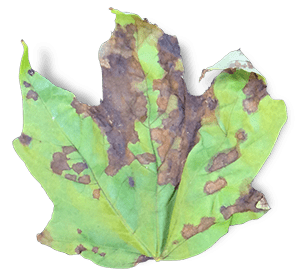
Anthracnose
Anthracnose is a common leaf disease caused by several different kinds of fungi. These various fungi typically infect newly emerging leaves in spring. Infected leaves will develop tan, brown or black blotched areas. Leaf distortion is also a common effect. Anthracnose can also affect stems and branches in some trees and shrubs. Symptoms tend to be worse when spring weather is cool and wet. Anthracnose can be unsightly; however, it will not result in the death of your tree.
Trees prone to Anthracnose include: Oak, Maple, Ash, Hickory, Sycamore, Walnut, and other shrubs and garden plants

How to identify damages caused by Anthracnose
Early Signs
- In spring and early summer leaves will develop brown or black areas on the leaves.
- Spores spread during cool and rainy weather.
- Infectious cankers on twigs and branches.
- Leaf distortion is also common.
Late Signs
- Foliage will appear damaged and some leaf drop may occur.
- Depending on the severity, your tree may die.
- Most trees re-leaf by mid-summer.
Anthracnose Prevention
For Homeowners
- Raking up and disposing of infected foliage may help lessen the disease in proceeding years, composting of leaves is the best method of disposal.
- Supplemental watering of trees if summer is dry would be beneficial.
Anthracnose Prevention
For Professionals
- Provide proper diagnosis
- Provide guidance for overall tree care
- Suggest management strategies to combat the disease
- Use of foliar or systemic fungicides to combat the disease

Anthracnose Treatment

Anthracnose FAQs
Can trees be sprayed in summer when the disease is evident?
No, often the trees need to be preventively treated in spring as the leaves are developing for best results.
Will my trees get anthracnose every year?
Some trees are more susceptible than others, however, weather conditions are the primary factor in severity from year to year.


